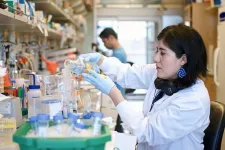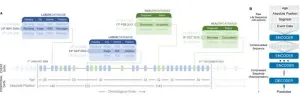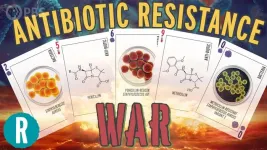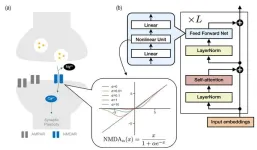(Press-News.org) (Memphis, Tenn.—December 18, 2023) Children with bilateral Wilms tumor have a tumor in each of their kidneys — a condition that strongly suggests an underlying genetic or epigenetic predisposition driving the disease. Scientists at St. Jude Children’s Research Hospital gathered a large cohort of bilateral Wilms tumor samples and conducted analyses to assess which factors contribute to predisposition comprehensively. The work has implications for counseling patient families, guiding treatment decisions and informing the design of future clinical trials. The study was published today in Nature Communications.
Having tumors in both organs makes treating bilateral Wilms tumor more complicated. When Wilms tumor occurs in just one kidney, surgeons can remove the entire organ. But with bilateral Wilms tumor, removing both kidneys would eliminate renal function. Instead, patients first need chemotherapy to shrink the tumors as much as possible, followed by organ-sparing surgery to remove the tumors without removing the whole kidney.
“We see a lot of patients with bilateral Wilms tumor here at St. Jude, offering these organ-sparing surgeries so that patients do not become dependent on dialysis and require kidney transplants,” said co-corresponding author Andrew Murphy, MD, St. Jude Department of Surgery. “This means we were also uniquely privileged to have access to patient tissue samples to enable us to do this research, to establish the relative frequencies of different modes of predisposition.”
The researchers gathered a cohort of bilateral Wilms tumor samples from patients treated at St. Jude as well as on the Children’s Oncology Group study AREN18B5-Q. This cohort, the largest reported for bilateral Wilms tumor, allowed the researchers to conduct whole exome, whole genome, RNA-sequencing and DNA methylation analyses to unravel the factors involved in predisposition.
Genetic and epigenetic factors drive Wilms tumor predisposition.
Through their analyses, the researchers determined the predominant genomic events predisposing patients to bilateral Wilms tumor. These include pre-zygotic germline (inherited) variants detectable in blood samples, such as WT1, NYNRIN, TRIM28 and BRCA-related genes.
The researchers also identified an epigenetic mechanism causing predisposition. They found post-zygotic (forming in the early embryo) hypermethylation at 11p15.5 H19/ICR1 predisposes patients to bilateral Wilms tumor. DNA methylation is a fundamental biologic process in which methyl groups are added to the cytosine residues of DNA. The process guides the instructions for how gene expression is regulated. In this case, abnormal hypermethylation on the copy of chromosome 11p15.5 inherited from the mother leads to increases in gene expression. In bilateral Wilms tumor, this phenomenon (also called loss of imprinting at 11p15.5) leads to the increased expression of IGF2 — one of the major genes previously implicated in predisposition.
The researchers also found evidence of hypermethylation at 11p15.5 in the blood of patients with bilateral Wilms tumor, not just the tumor or in the non-diseased kidney. This hypermethylation signature was found at higher levels than in unilateral Wilms tumor or healthy individuals.
“Realizing that a pair of bilateral tumors from the same patient shared almost no somatic mutations, we suspected there were several ways genomes predisposed patients to develop bilateral Wilms’ tumors, but it is essential to drive the research forward to holistically determine their frequency and interplay across a large cohort,” said co-corresponding author Xiang Chen, PhD, St. Jude Department of Computational Biology. “We needed to study germline and post-zygotic factors by integrating analyses, and we have now thoroughly characterized the landscape of predisposing events.”
A ‘mosaic’ of predisposing factors
Wilms tumor is the most common kidney cancer of childhood, but just 5-7% of all Wilms tumor patients are diagnosed with bilateral Wilms tumor. Patients with bilateral Wilms tumor are diagnosed younger and often have precursor lesions called nephrogenic rests (clusters of undifferentiated embryonic kidney cells).
For decades, researchers suspected that bilateral Wilms tumor likely occurred due to a convergence of pre- and post-zygotic genomic effects: two (or more) genetic hits that together form a variety of effects driving predisposition. The St. Jude team’s work provides support for the concept of mosaicism, where these predisposing genetic or epigenetic abnormalities are found in some, but not all, cells in the body. Based on this new understanding, researchers are already exploring ways to incorporate these findings in the design of the next co-operative group clinical trial for Wilms tumor.
“We hope that once these data are established, these findings will become prospective biomarkers for treatment response or prognosis and can be included in the next generation of clinical trials,” said Murphy.
Authors and funding
The study’s co-first author is Changde Cheng, St. Jude. Other authors include Jack Brzezinksi, The Hospital for Sick Children; Lindsay Renfro, Children’s Oncology Group and Keck School of Medicine of University of Southern California; Brett Tornwall, Children’s Oncology Group Statistics and Data Center; Vicki Huff, MD Anderson Cancer Center; Andrew Hong, Emory University School of Medicine; Elizabeth Mullen, Dana-Farber/Boston Children’s Cancer and Blood Disorders Center, Harvard Medical School; Brian Crompton, Dana-Farber/Boston Children’s Cancer and Blood Disorders Center, Harvard Medical School and Broad Institute of Harvard and MIT; Jeffrey Dome, Children’s National Hospital, George Washington University School of Medicine and Health Sciences; Conrad Fernandez, Dalhousie University; James Geller, Cincinnati Children’s Hospital Medical Center; Peter Ehrlich, C.S. Mott Children’s Hospital, University of Michigan; Michael Clay, University of Colorado Anschutz; and Justin Williams, Timothy Shaw, Emilia Pinto, Karissa Dieseldorff-Jones, Heather Mulder, Ninad Oak, Jamie Maciezsek, Carolyn Jablonski, Andrew Fleming, Prahalathan Pichavaram, Christopher Morton, John Easton, Kim Nichols, Teresa Santiago, Jinghui Zhang, Jun Yang, Gerard Zambetti, Zhaoming Wang and Andrew Davidoff of St. Jude.
The study was supported by the American Pediatric Surgical Association Foundation Jay Grosfeld Scholarship; the American Cancer Society-Research Scholar Grant (1304210RSG0170071-01-TBG); the NCTN Operations Center Grant (U10CA180886), the NCTN Statistics & Data Center Grant (U01CA180899); The National Institutes of Health/National Cancer Institute (1K08CA255569-01, 1L40CA242492-01, 1R01CA229739-01, 5P30CA021765-41, U10CA098543, U10CA098413 and U24CA114766); and ALSAC, the fundraising and awareness organization of St. Jude.
St. Jude Media Relations Contacts
Chelsea Bryant
Desk: (901) 595-0564
Cell: (256) 244-2048
chelsea.bryant@stjude.org
media@stjude.org
Rae Lyn Rushing
Cell: (901) 595-4419
RaeLyn.Rushing@stjude.org
media@stjude.org
St. Jude Children's Research Hospital
St. Jude Children's Research Hospital is leading the way the world understands, treats and cures childhood cancer, sickle cell disease and other life-threatening disorders. It is the only National Cancer Institute-designated Comprehensive Cancer Center devoted solely to children. Treatments developed at St. Jude have helped push the overall childhood cancer survival rate from 20% to 80% since the hospital opened more than 60 years ago. St. Jude shares the breakthroughs it makes to help doctors and researchers at local hospitals and cancer centers around the world improve the quality of treatment and care for even more children. To learn more, visit stjude.org, read St. Jude Progress blog, and follow St. Jude on social media at @stjuderesearch.
END
Unraveling predisposition in bilateral Wilms tumor
2023-12-18
ELSE PRESS RELEASES FROM THIS DATE:
Feelings of impatience evolve over time, study says
2023-12-18
A new study answers a timely question: What is the hardest part of waiting? Consumers do plenty of it—online, in line, in traffic, or for deliveries. And now we know it’s the final phase that’s most problematic for them.
In this season of joyful—and not-so-joyful—anticipation, the research has deep implications for marketers and psychological insights for us all, says Annabelle Roberts, coauthor and assistant professor of marketing at the University of Texas McCombs School of Business. The paper shows:
It’s better for companies to communicate possible delays early in the wait;
It’s better for ...
Little bacterium may make big impact on rare-earth processing
2023-12-18
ITHACA, N.Y. - A tiny, hard-working bacterium – which weighs one-trillionth of a gram – may soon have a large influence on processing rare earth elements in an eco-friendly way.
In a new study, Cornell University scientists show that genetically engineering this bacterium could improve the efficiency for the purification of elements found in smartphones, computers, electric cars and wind turbines, and could even boost global economic supply chains.
Vibrio natriegens, the bacterium, offers a sustainable ...
AI generates proteins with exceptional binding strengths
2023-12-18
A new study Dec. 18 in Nature reports an AI-driven advance in biotechnology with implications for drug development, disease detection, and environmental monitoring. Scientists at the Institute for Protein Design at the University of Washington School of Medicine used software to create protein molecules that bind with exceptionally high affinity and specificity to a variety of challenging biomarkers, including human hormones. Notably, the scientists achieved the highest interaction strength ever reported between a computer-generated biomolecule and its target.
Senior author David Baker, professor of biochemistry at UW Medicine, ...
Artificial intelligence can predict events in people's lives
2023-12-18
Artificial intelligence developed to model written language can be utilized to predict events in people's lives. A research project from DTU, University of Copenhagen, ITU, and Northeastern University in the US shows that if you use large amounts of data about people's lives and train so-called 'transformer models', which (like ChatGPT) are used to process language, they can systematically organize the data and predict what will happen in a person's life and even estimate the time of death.
In a new scientific article, 'Using Sequences of Life-events to Predict Human Lives', published ...
Einstein receives $10.9 million grant to validate remote cognitive testing for Alzheimer’s and other dementias
2023-12-18
December 18, 2023—(BRONX NY)—Neurologists often diagnose Alzheimer’s disease after evaluating patients during lengthy, in-person office visits. This poses a significant challenge for many groups, particularly people with limited access to specialized care, including people from historically marginalized groups and people living in rural areas.
Albert Einstein College of Medicine has received a five-year, $10.9 million grant from the National Institutes of Health (NIH) to study whether remote neuropsychological testing can substitute for in-person office visits when assessing whether people have Alzheimer’s disease or other dementias.
“In-person ...
The antibiotic resistance war (video)
2023-12-18
WASHINGTON, Dec. 18, 2023 — There’s a microscopic battle happening right before our eyes, involving the critical issue of antibiotic resistance. Witness the historical development of antibiotics, from penicillin's accidental discovery to the ongoing battle against superbugs. https://www.youtube.com/watch?v=OCR5wFWSGlA
Reactions is a video series produced by the American Chemical Society and PBS Digital Studios. Subscribe to Reactions at http://bit.ly/ACSReactions and follow us on Twitter @ACSReactions.
The American Chemical Society (ACS) is ...
AI's memory-forming mechanism found to be strikingly similar to that of the brain
2023-12-18
An interdisciplinary team consisting of researchers from the Center for Cognition and Sociality and the Data Science Group within the Institute for Basic Science (IBS) revealed a striking similarity between the memory processing of artificial intelligence (AI) models and the hippocampus of the human brain. This new finding provides a novel perspective on memory consolidation, which is a process that transforms short-term memories into long-term ones, in AI systems.
In the race towards developing ...
15th annual horizon scan identifies 15 most pressing issues for conservation, including invertebrate decline and changing marine ecosystems
2023-12-18
Since 2009, the Cambridge Conservation Initiative has coordinated an annual horizon scan, a well-established method for predicting which threats, changes, and technologies will have the biggest impact on biological conservation in the following year. This year, the 15th horizon scan included 31 scientists, practitioners, and policymakers who developed a list of 96 issues, which they eventually narrowed down to the fifteen most novel and impactful. Their findings, publishing in the journal Trends in Evolution & Ecology ...
Toothbrushing tied to lower rates of pneumonia among hospitalized patients
2023-12-18
Toothbrushing also associated with lower rates of ICU mortality, shorter duration of mechanical ventilation, and shorter ICU length of stay
Researchers say toothbrushing could be a cheap but effective way to help lower rates of hospital-acquired pneumonia
Researchers have found an inexpensive tool that may help reduce rates of pneumonia for hospitalized patients—and it comes with bristles on one end. A new study by investigators from Brigham and Women’s Hospital, a founding member of the Mass General Brigham healthcare system, and Harvard Pilgrim Health Care Institute ...
Ecosystem benefits to humanity expected to decline by 9% by 2100
2023-12-18
As climate change redistributes terrestrial ecosystems across the globe, the world’s natural capital is expected to decrease, causing a 9% loss of ecosystem services by 2100. That’s according to a study of natural capital published today in the journal Nature led by scientists at the University of California, Davis, and Scripps Institution of Oceanography at UC San Diego.
Breathable air, clean water, healthy forests and biodiversity all contribute to people’s well-being in ways that ...









